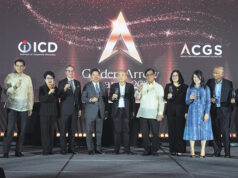Going beyond the traditional work setting
By Mark Louis F. Ferrolino, Special Features Writer
Working environment in the Philippines, particularly in the past 10 years, went through rapid and significant changes. From the traditional cubicle-style setup, primarily designed for employees to stay focused all the time, workplaces today have open space design that encourage collaboration and creativity between staff. And as key developments in the realm of office culture take place, the way people perform their work has also evolved.
Technology is revolutionizing the local working environment, offering boundless opportunities for the employees to be productive and efficient with utmost convenience. Devices such as smartphones, tablets and laptops allow employees to send e-mails, check documents, and talk to their colleagues anytime and anywhere. Video conference also allows people to participate in important meetings wherever they are.
Lars Wittig, country manager of Regus Philippines, shared in an e-mail to BusinessWorld that as generations grow up in this kind of setting — expecting to be able to communicate cheaply and rapidly from anywhere in the world — it follows that they expect this to also be the case in the professional arena.
As a result, flexible workspaces continue to become a trend. According to a report by real estate consulting services firm Colliers International in 2017, the estimated total stock of flexible workspaces in Metro Manila has reached 228,000 square meters. The firm expects this number to grow by 10% annually in the next three years, as demand for co-working spaces is spurred by millennials who dominate the local labor force.
Flexible working spaces, as explained by Colliers, are any workplaces that allow short-term leases, with a minimum size of one seat, fully-furnished and ready-to-use. In the Philippine market, it is grouped into three major classifications: serviced offices; hosted services firms; and co-working spaces, which all provide basic needs of air-conditioning, comfortable workstations, and fast Internet.
“The rise of business process outsourcing (BPO) start-ups and Internet businesses in the Philippines has fueled the demand for flexible workplace solutions. As the commercial real estate in Metro Manila becomes prohibitive, we find that flexible workspaces solutions become more as these allow enterprises to scale up or down according to market sentiments and business needs and performance, while enjoying greater accessibility and proximity to customers,” Mr. Wittig said.
Having a flexible workspace is important for employees who want to manage work-life balance. Thus, for start-ups to drive business growth and for well-established companies to expand further, providing the ideal work environment for employees while avoiding unnecessary costs is a great plan.
In an interview with BusinessWorld, KMC Solutions Chairman and Co-Founder Gregory Kittelson said that design, atmosphere and amenities are vital to boost the employees’ morale and productivity.
“So, make offices as comfortable and attractive as possible, creating a good atmosphere, where if employees had to work on a weekend, they would prefer to work in your office instead of working from home or a coffee shop,” he explained.
Other than this, giving employees a workplace with some health and wellness features has great benefits to the employees and company, ensuring a happier and stronger work force, he added.
Some KMC Solutions offices have yoga studios and a skydeck where employees do circuit training, Mr. Kittelson shared.
“As more and more workers demand to work flexibly, and with all the technology available to enable them to do so productively, businesses are marrying their need for greater agility with helping workers achieve greater personal happiness and work-life balance. This is an important aspect to consider for businesses seeking to acquire top talent, as today’s workers are reporting that it’s not just salary which makes a difference. Add to this the fact that our research shows improved concentration levels and productivity are benefits of flexible working, and the business case is made,” Mr. Wittig said.
Today, the majority of flexible workspace occupiers in the country are foreign companies or individuals, Mr. Kittelson said. “But I think a lot of Filipino companies are now starting to see the advantage of working out of a flexible workspace, whether a serviced office or hip new co-working space.”
Down the line, the millennial generation, who are known for their entrepreneurial mind-set, tech and mobile habits, are assumed to continuously pioneer changes in the traditional business practices.
Thus, companies who stick to a traditional mind-set will lose their attractiveness as an employer and will miss the chance to obtain the large, productive and motivated millennial work force.
“We believe office leases will become shorter and shorter as this young generation continues to gain significant influence, and that demands and expectations will continue to conform to flexible millennial lifestyles. As employees continue to modify their approach to work and career, employers will inevitably follow, and so will commercial real estate developers,” Mr. Wittig said.
For his part, Mr. Kittelson said that companies no longer look for a three- to five-year plan — they rather look at a six- to 12-month plans — not just in the Philippines but around the world. This, on the other hand, indicates the greater need of companies to have a more flexible setup in the workplace now and in the future.
“Given mobile workspaces, given technology, given market trends, at the end of the day, companies don’t have these long-term plan — it is really reduced to a 12-month plan. So, that said, they want the flexibility, they want that plug-in place solutions, someone who could offer the exact private room size that they want, giving them the ability to scale up or scale down,” he explained.


